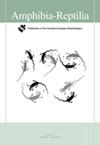Hang in there: comparative arboreal prey-handling in boa constrictors and ball pythons
IF 1.3
4区 生物学
Q3 ZOOLOGY
引用次数: 1
Abstract
Snakes are a diverse group of reptiles, having colonized almost every environment on the planet. Multiple snake lineages have independently evolved semiarboreal or completely arboreal species. As snakes lack limbs, the challenges of moving and feeding in an arboreal environment are numerous. Here we compare the prey-handling ability of the semiarboreal boa constrictor to the terrestrial ball python in a simulated arboreal context. Snakes were allowed to strike at rodent prey and attempt to swallow that prey while suspended. Boa constrictors were successful in feeding, using a complex suite of behaviors to maintain their position and manipulate their prey. Boa constrictors positioned rats so that swallowing occurred in the direction of gravity, and would use loops of their body to support the rat during swallowing. Ball pythons were frequently not successful in feeding, lacking the complex behaviors that boa constrictors frequently employed. Ball pythons would attempt to swallow, but in the majority of feeding attempts were ultimately unsuccessful. These unsuccessful feeding attempts were typically characterized by the ball pythons hanging upside-down, trying to swallow the prey against the direction of gravity. We suggest that behavioral modifications to feeding encouraged successful invasion of arboreal habitats, but more sampling of snake diversity is needed to explore the range and types of feeding behaviors that arboreal snakes employ.坚持住:蟒蛇和球蟒在树上捕食的比较
蛇是一种多样的爬行动物,几乎在地球上的每一个环境中都有分布。多个蛇谱系已经独立进化出半树栖或完全树栖的物种。由于蛇缺乏四肢,在树栖环境中移动和进食的挑战是巨大的。在这里,我们在模拟的树栖环境中比较了半水生蟒蛇和陆地球蟒对猎物的处理能力。蛇被允许攻击啮齿动物的猎物,并试图在悬挂期间吞下猎物。蟒蛇成功地进食,利用一系列复杂的行为来维持它们的位置和操纵猎物。蟒蛇将大鼠定位在重力方向,使其吞咽,并在吞咽过程中使用身体的环来支撑大鼠。球蟒经常不能成功进食,缺乏蟒蛇经常采用的复杂行为。球蟒会尝试吞咽,但在大多数喂食尝试中最终都没有成功。这些不成功的进食尝试的典型特征是球蟒倒立,试图逆重力方向吞下猎物。我们认为,进食行为的改变鼓励了对树栖栖息地的成功入侵,但需要对蛇的多样性进行更多的采样,以探索树栖蛇采用的进食行为的范围和类型。
本文章由计算机程序翻译,如有差异,请以英文原文为准。
求助全文
约1分钟内获得全文
求助全文
来源期刊

Amphibia-Reptilia
生物-动物学
CiteScore
3.10
自引率
6.20%
发文量
39
审稿时长
6-12 weeks
期刊介绍:
Amphibia-Reptilia is a leading European multi-disciplinary journal devoted to most of the aspects of herpetology: ecology, behaviour, evolution, conservation, physiology, morphology, paleontology, genetics, and systematics.
Amphibia-Reptilia publishes high quality original papers, short-notes, reviews, book reviews and news of the Societas Europaea Herpetologica (SEH). The Societas Europaea Herpteologica (SEH) website is located at: www.seh-herpetology.org.
 求助内容:
求助内容: 应助结果提醒方式:
应助结果提醒方式:


